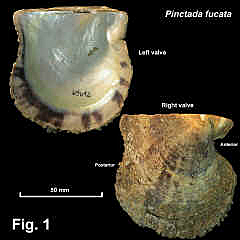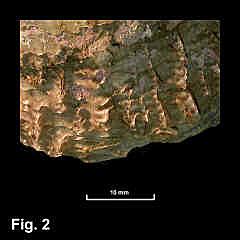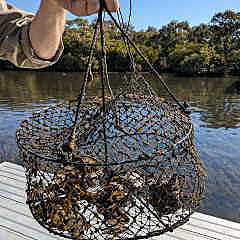|
|
MARGARITIDAE |
|
|
|
Pinctada fucata (A. Gould, 1850) Description: Shape Shell with left valve more inflated than right; umbo at anterior quarter of dorsal margin; dorsal margin straight, anterior margin with deep byssal notch in right valve, posterior margin straight or concave, ventral margin rounded. Hinge line straight, ligament in a broad triangular pit behind umbo. Interior nacreous, with a wide non-nacreous margin which is pale brown or with purple rays; single large, crescent-shaped muscle scar posterior to centre. Exterior smooth initially, developing concentric overlapping foliaceous laminae marginally, sometimes with finger-like processes. Shell colour variable; usually fawn with purple radial rays, finger-like processes brown banded (Fig. 2). Size: Up to 90 mm in length. Distribution: Indo-West Pacific; in Australia, occurs from south-western WA, around northern Australia and southwards to Mallacoota Inlet, Vic. Some authors (e.g. Huber (2010)) regard P. fucata as a component of a worldwide species Pinctada imbricata Röding, 1798. Habitat: Lives in fairly muddy environments, laying on the right valve, attached by a byssus to seagrasses or solid objects. Comparison. Below is a summary of the key characters distinguishing the seven species of pearl oysters that occur in NSW: Pinctada fucata is a medium-sized species that is relatively inflated. It is characterised by brown bands on the foliaceous processes. It is one of the two moderately common species in central NSW. P. albina is large, not much inflated, uniformly light coloured, with relatively few foliaceous processes. It is the second moderately common species in NSW. P. nigra is like P. albina but dark in colour, and medium-sized. P. chemnitzii is medium-sized, fairly smooth externally. Internally the left valve has a significantly larger nacreous area than the right. P. maculata is a medium-sized species that is relatively inflated. It often has white patches, or rays, or flecks. Its foliaceous processes are never brown banded. P. margaritifera is a large species, with a black shell with white rays. P. maxima is a large species, with moderately inflated shell. It has numerous rounded processes, which are never banded. Synonymy: Names used for this species in NSW include Pinctada imbricata Röding, 1798 and Pinctada perviridis (Reeve, 1857). Huber (2010) considered the worldwide distribution of this group to indicate only a single species and so he used the oldest name Pinctada imbricata Röding, 1798 for it. But work by Cunha et al. (2011) does not support the single cosmopolitan species hypothesis, so maintain several species, or subspecies, in Indo-West Pacific, western Atlantic and eastern Indian Ocean. For the Indo-West Pacific region, in which NSW is included, the name P. fucata (A, Gould, 1850) is applicable. Remarks: A single company cultivates pearl oysters commercially in NSW. Broken Bay Pearls Pty. Ltd. cultivates Pinctada fucata in Broken Bay near Woy Woy, NSW (Fig. 3). Brood stock is collected from the wild along the NSW coastline, and spawned at the company’s hatchery. Spat is collected six weeks after spawning when shells are approximately 1 mm in size. Spawn is grown in fine mesh baskets suspended about half a metre below the water surface. When about 2.5 years old, at a hinge length of 40-50 mm, a spherical nucleus made from American freshwater mussel is carefully inserted into the gonad along with a small section of the pearl oyster’s own mantle tissue. The animals are then grown out for a further 1.5-2.5 years in baskets suspended by ropes at less than a metre deep. A mother-of-pearl layer is deposited around the nucleus. The oysters are harvested and the pearls removed and graded for sale. Fig. 1: Gunnamatta Bay, Port Hacking, NSW (C.69642) Fig. 2: Colouration on foliaceous processes (C.69642) Fig. 3: Shells in grow-out basket in Broken Bay, NSW |
|


